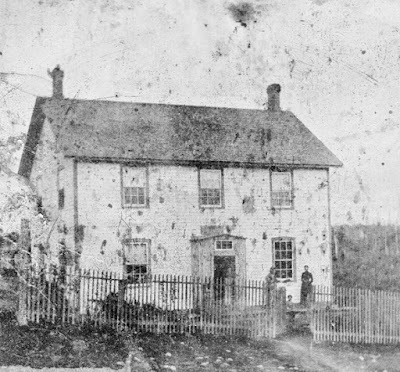Sarah Ann Wilson Aug 1854, (QUILT #1)
Collection of the Art Institute of Chicago
Restricted gift of Mrs. David W. Grainger, 1999.509
Fans of antique quilts are familiar with this pictorial quilt with its double scalloped edging and red sashing. It's been published several times over the past forty years and it's been in the collection of the Art Institute for about twenty. I've always liked the dots on the red and green scallops.
I knew I had seen several pictorial sampler quilts with that fancy scalloped edge and I now find I have pictures of four. five.
1859, probably New York (QUILT #2)
This one has two scallops too but no dots.
It's an orphan photo, floating around on one of those sites
that does giclee prints of art. At least they captioned it with
date and place.
Anna Putney Farrington (ca 1825-1911), Westchester County, NY
Dated 1857 (QUILT #3)
Collection of the Farmers' Museum
Fenimore Art Museum
http://www.fenimoreartmuseum.org/farmers/collections/textiles
Anna used a similar double scallop. Scallop finishes are not that common in mid-19th century quilts, and double scallops catch the eye. I recently realized there is a fourth in this set. I hadn't look closely and I just filed this away as another picture of the 1854 Wilson quilt (#1)
Arlene Perkins & Charlotte Winter, watercolor, painted in 1941 for the W.P.A. (QUILT #4)
Collection: National Gallery of Art. Quilt found in New York City.
This is not an actual quilt; it's one of those accurate W.P.A. paintings of
a folk art object. It has a single scallop with dots.
The National Gallery had noticed the similarity to Quilt #1.
Before I posted this I noticed a fifth. It's not as closely related
but the double scallop is intriguing and it's from New York.
Dated 1847 Mary Catherine Dearborn Chase Close,
Westchester County, New York
Quilt #5 is not quite so similar.
These five quilts share numerous style characteristics.
The scallop may be the most unique. The flat figurative images are also distinctive. The first four quilts have blocks set on the square with a narrow red sash. Three of those four are 7 blocks across by 6 down (Sarah's is 6x5.)
The blocks are not only flat stylized applique, rather isolated in the center of each square, but the quilts share similar conventional applique designs like this 8 lobed floral.
#1 on left; #2 on right
And mainly more unusual pictorials.
#1 at top; #2 below
Double trees in ##1 on left; #2 on right
Yellow houses with birds and pairs of trees.
#1 on left; #3 on right
#5 also has a yellow house and a bird.
From #1
And, of course, the silhouetted paper-doll like black figures
with the women in aprons in #1 and #4.
The figures apparently have facial features embroidered so it does appear that they are not meant to be silhouettes but black characters. Black stereotypes were typical in all kinds of imagery so this does not tell us the race of the quiltmakers.
I found a little about Anna Putney Farrington who was born in 1820 according to the cemetery records and thus about 34 when she made her quilt. Her husband was Hiram Farrington (1830-1906) and they are buried in the Amawalk Friends' Cemetery in Westchester County NY.
The cemetery at Amawalk
Hiram was postmaster in the early 1880s
in Cornell – Kitchawan.
Sarah Ann Wilson is harder to find, but I bet she's from New York too, maybe Westchester County.
What was going on in New York in the 1840-1860 period? Were people selling patterns? Making kits? Showing off their quilts at fairs to inspire copies? Teaching classes? Was that yellow house a school?























































